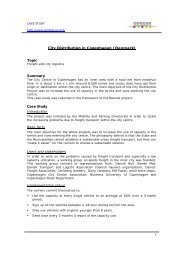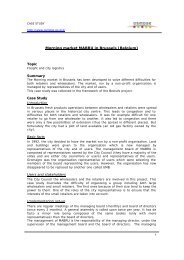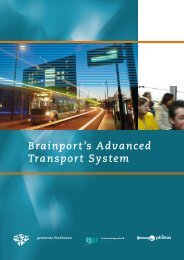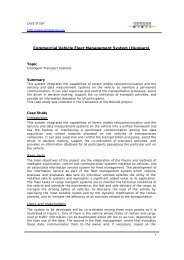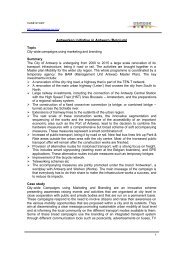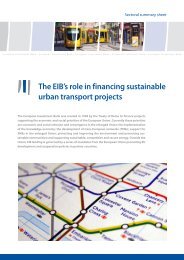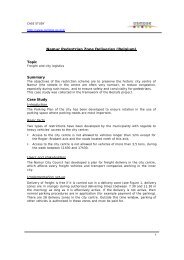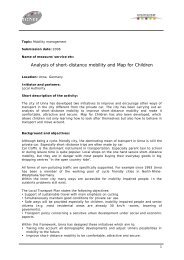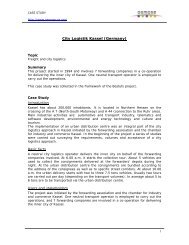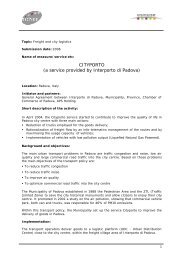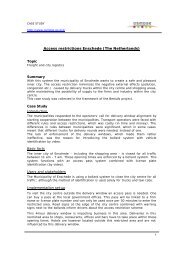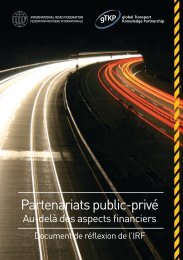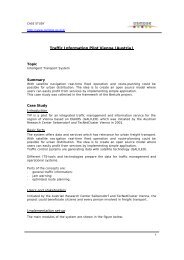C2.4. Hoadley - Osmose
C2.4. Hoadley - Osmose
C2.4. Hoadley - Osmose
You also want an ePaper? Increase the reach of your titles
YUMPU automatically turns print PDFs into web optimized ePapers that Google loves.
UNIACCESS<br />
Design of Universal Accessibility Systems for Public Transport<br />
Susanne <strong>Hoadley</strong>, Kristin Ulven Jørgensen*,<br />
POLIS, Rue du Trône 98, 1050 Bruxelles, Belgium<br />
*SINTEF Health Research 7465 Trondheim, Norway<br />
shoadley@polis-online, Kristin.u.jorgensen@sintef.no,<br />
Keywords: Universal design, accessibility, public transport, state-of-the-art, R&D roadmap<br />
ABSTRACT<br />
Uniaccess is a 2-year project whose aim is to define concepts for universal accessibility in public<br />
transport. The project promotes and supports the networking and coordination of research and<br />
innovation activities in the field of universal design of accessibility systems for public transport<br />
with a view to achieving equality of access to public transport in the EU. These are the main<br />
activities of the project:<br />
1. a state of the art exercise to provide a picture of current situation in relation to public<br />
transport infrastructure and vehicles and relevant legislation and standards.<br />
2. the establishment of a Research & Development roadmap<br />
3. building an understanding of the frequency & intensity of interaction between the<br />
different stakeholders (designers/manufacturers, operators, authorities and end users)<br />
4. and finally, awareness raising activities to sensitise the stakeholder groups, media and<br />
public to the Uniaccess project and public transport accessibility in general<br />
WHAT IS UNIACCESS?<br />
Uniaccess is a 2-year project whose aim is to define concepts for universal accessibility in public<br />
transport. It is funded by the European Commission through the Sixth Framework Programme for<br />
Research and Development.<br />
The project promotes and supports the networking and coordination of research and innovation<br />
activities in the field of universal design of accessibility systems for public transport with a view<br />
to achieving equality of access to public transport in the EU.
WHY UNIACCESS?<br />
Uniaccess was developed in response to an observation that something was failing in the current<br />
system of public transport accessibility:<br />
‣ Many accessibility devices are too often out of order, typically ramps.<br />
‣ When a person with reduced mobility has to make a journey with connections (often<br />
intermodal), he/she frequently finds discontinuity in the disabled accessibility<br />
provisio ns. This discourages people with reduced mobility from using public<br />
transport over long distances.<br />
‣ Due to the extra deployment time required to (dis)activate current accessibility<br />
systems, the use of these systems very often causes anger in drivers and travellers<br />
without mobility problems as well as frustration and embarrassment in people with<br />
disability.<br />
‣ A large group of people with minor mobility problems, such as temporary injuries,<br />
people with shopping bags, carry babies or children, and elderly people, avoids<br />
using public transport because it does not meet their needs. This causes in many<br />
cases the use of less sustainable modes of transport such as the private car or taxi<br />
instead of public transport.<br />
‣ Design for all principles have been widely adopted in the built environment, while<br />
transport seems to stick to differentiated access systems, ie, a solutions for a specific<br />
disability rather than a universal solution address a range of disabilities.<br />
The above problems are compounded by public perception that people with reduced mobility are<br />
restricted to the ‘conventionally’ disabled, e.g., wheelchair users and blind or deaf people, and<br />
therefore, implementing ‘expensive’ devices for such a small group of people (whom one rarely<br />
sees on the street) is not an efficient use of resources. This could not be further from the truth.<br />
The term reduced mobility does not just encompass the ‘conventionally’ disabled as described<br />
above but also those with difficulties walking, standing, gripping or understanding, expectant<br />
mothers, people suffering from temporary injuries and people below the age of 3 and over 65; ie,<br />
26% of the European population.<br />
Therefore, beyond and above meeting basic human rights for all people to be able to use public<br />
transport safely and with dignity, a universally accessible public transport system can be justified<br />
as follows:<br />
‣ There is a hidden group of potential public transport users that either do not use it or<br />
do it with a variable degree of dissatisfaction.<br />
‣ Universal accessibility is achievable at low cost and it offers a lot of advantages for<br />
everybody. An accessible public transport system benefits all passengers, the quality<br />
of a system is often a key factor in modal choice decisions.<br />
‣ More accessible transport can reduce the need for specialised transport means<br />
required by the elderly and disabled people.
MAIN ACTIVITIES OF UNIACCESS<br />
The main activities in the Uniaccess project are summarized in figure 1.<br />
WP2. Current<br />
situation and<br />
state of the art<br />
studies<br />
WP3. Roadmap of<br />
future R&D and<br />
emerging concepts<br />
WP4.<br />
Coordination of<br />
research and<br />
development<br />
WP5. Dissemination and awareness<br />
Figure 1. Main activities for the Uniaccess project.<br />
1. a state of the art exercise to provide a picture of current situation in relation to public<br />
transport infrastructure and vehicles and relevant legislation and standards.<br />
2. the establishment of a Research & Development roadmap<br />
3. building an understanding of the frequency & intensity of interaction between the<br />
different stakeholders (designers/manufacturers, operators, authorities and end users)<br />
4. and finally, awareness raising activities to sensitise the stakeholder groups, media and<br />
public to the Uniaccess project and public transport accessibility in general<br />
1. State of the art<br />
The purpose of this activity was to establish a picture of the current situation regarding<br />
accessibility in public transport in terms of infrastructure, vehicles and legislation and standards.<br />
This exercise was accomplished by gathering the viewpoints of the full range of stakeholders, ie,<br />
end users, operators, authorities and manufacturers/designers, and also benefited from the input<br />
of accessibility experts from around Europe.<br />
a. Infrastructure<br />
This covers railway, metro and bus stations/interchanges as well as bus stops. It deals with the<br />
physical environment (doors, walkways, platforms, ticket machines etc) as well as<br />
communication (audio and written). It would seem that infrastructure owners are becoming more<br />
and more committed to accessibility (partly due to legislation). Progress is quicker for new<br />
infrastructure but slower, more expensive and less efficient where retrofitting is concerned.<br />
b. Vehicles<br />
Technological progress with regards to vehicles (buses, metros and taxis) tends to have<br />
concentrated on ramps and there are many solutions on the market. However, boarding is still<br />
found to be a problem for some passengers due to remaining gaps. Furthermore, this ‘solution’ is<br />
focused on boarding passengers only; there is a need to develop devices to facilitate seating and<br />
to provide a safe and comfortable journey. Again the general solution pertained to the cost and
difficulties of retrofitting (particularly pertinent to vehicles with a long life such as trams and<br />
trains).<br />
c. Legislation & standards<br />
The existence of national/regional legislation on accessibility in public transport varies widely<br />
around Europe and where legislation exists, there is diversity in terms of scope. However, there<br />
was a common view that the lack of conformity with legislation and enforcement were important<br />
concerns. Also, it was questioned whether legislation was the right tool for ensuring full<br />
accessibility.<br />
The absence of standards, especially regarding rolling stock, has resulted in the wide range of<br />
technical solutions on the market for devices such as ramps. Manufacturers are currently having<br />
to follow national guidelines (where available) but would rather work with standards.<br />
In the course of reviewing existing legislation & standards, it became clear that action was also<br />
needed in relation to society awareness. People with reduced mobility face additional barriers to<br />
using public transport due to public attitudes for instance (eg, impatience due to the time required<br />
for a wheelchair user to board) or irresponsible driving behaviour (eg, pulling away before an<br />
elderly passenger is seated).<br />
2. Road map for future research and development<br />
Having built up a picture of the current situation, the next major activity was the construction of<br />
the roadmap. This was achieved following the methodology outlined in figure 2.<br />
Figure 2. The process for developing the roadmap<br />
Firstly, a series of accessible journey scenarios were prepared in order to define a vision of the<br />
future. The scenarios were analysed in terms of strategic moments and strategic physical points in<br />
the journey chain and the requirements (technological and other) for the scenario to become a<br />
reality were extracted. From these requirements, specific solutions were defined and graded<br />
according to their degree of universality in terms of transport mode (bus, metro, tram, train and<br />
taxi) and type of mobility impairment of which 9 categories were identified. Finally, the gap<br />
between the current situation and proposed solutions was identified, ie, what is missing. A total
of 59 requirements for the entire transport journey were identified which, together with their<br />
corresponding solutions and gaps, form the Emerging Concepts on transport infrastructure and<br />
means. Two examples of requirements and corresponding solutions and gaps can be found in<br />
Annex 1.<br />
A separate task dealing with emerging concepts in legislation, standards, policy and society was<br />
also prepared and comprised 15 requirements. An example of one requirement can be found in<br />
Annex 2.<br />
The next step concerned the preparation of the Research & Development roadmap. This roadmap<br />
was prepared on the basis of an analysis of the Emerging Concepts and specifically the solutions<br />
needed to deliver a given requirement. Each solution to a requirement was studied and selected<br />
for the road map on the basis of whether it required research and development. The roadmap is<br />
organised according to the 5 steps in any journey chain: before the journey (eg, travel information<br />
& booking); to the terminal or bus stop; at the terminal, platform or bus stop; getting into/out of<br />
the transport vehicle; during the journey. It also contains a separate section on R&D in relation to<br />
legislation, standards, policy and society.<br />
The roadmap will be used as a basis for preparing future research and development proposals.<br />
3. Collaborative process<br />
The objective is to define a new improved collaborative innovation process which breaks the<br />
communication barriers that prevent us nowadays from taking full advantage of the contributions<br />
of all stakeholders to improve accessibility to transport. Our vision is that the innovation process<br />
regarding public transportation should involve collaboration fr om all relevant parties and thereby<br />
ensuring that the new or improved transportation solutions coming out of the process will be<br />
universally accessible. Based on modern design methodology and insight in collaborative group<br />
processes, an integrated process model with relevant stakeholders will be described. A<br />
description of the current situation will be input to the development. To find the right way<br />
forward, it is useful to try to describe the ideal solution. The ideal situation; a collaborative<br />
innovation process is a process with a structure which ensures good solutions.<br />
Experience has shown that accessibility design is a multidisciplinary problem that demands a<br />
highly coordinated approach. End users must validate new designs; they must also communicate<br />
their needs and assessment of the current situation. Designers and manufacturers must find costeffective<br />
viable solutions. Operators must be taken into account so that what works in the<br />
laboratory also works in the real setting. Authorities must legislate and regulate taking all of this<br />
into account to achieve maximum effectiveness.<br />
4. Awareness raising<br />
Raising awareness among the key stakeholder groups (designers/manufacturers, operators,<br />
authorities and end users) is an important goal of the project. All four stakeholders are<br />
represented in the Uniaccess consortium. Additional activities such a newsletter, website, a<br />
universal design reference manual and several events have been set up to reach out to the<br />
different groups.
Specific actions have also been undertaken to raise society awareness to the important of<br />
universal accessibility in public transport. This has mainly been achieved through media<br />
activities.<br />
Partners of Uniaccess Project:<br />
AGE (European Older People's Platform, E.U.) Gives the older people requirements in the field<br />
of accessibility to transport.<br />
ENIL (European Network of Independent Living, E.U.) Pursues the goal of achieving<br />
independent living conditions for people with disabilities.<br />
COCEMFE (Spanish Confederation of People with Disabilities, Spain) Gives the people with<br />
disabilities’ requirements in the field of accessibility to transport.<br />
SINTEF (The Foundation of Scientific and Industrial Research at the Norwegian Institute of<br />
Technology, Norway) Expert in computer aided design and prototyping focused on usability and<br />
geometrical shape. It has an experience in coordinating complex research projects among many<br />
partners.<br />
GIAT-EUVE (Group of Interest in Accessibility to Transport – EUVE, Spain) Expert in<br />
computer aided design and prototyping focused on engineering as well as in managing projects of<br />
design of technical aids and in managing large thematic networks.<br />
GIAT-ICAVI (Group of Interest in Accessibility to Transport- ICAVI, Spain) Know-how in the<br />
range of technical aids in the market, their distribution by governments, and the training of endusers<br />
to use them as well as the dissemination of information to end-users and governments to<br />
optimally select the adequate technical aids taking into account both technical and sociological<br />
issues.<br />
CRF (FIAT Research Centre, Italy) Expert in full automobile, bus design and manufacture with a<br />
focus on ergonomic aspects and their compatibility with vehicle functions.<br />
SIEMENS (STS Siemens Transportation Systems GmbH & CO KG, Austria) Expert on railway<br />
and subway rolling stock design and manufacturing.<br />
POLIS (Cities and regions networking for innovative transport solutions, E.U.) It brings into the<br />
project the voice of authorities (primary decision makers) in the field of transport as well as the<br />
coordination with other innovation initiatives that they work on.<br />
RATP (Régie Autonome des Transports Parisiens, France) It brings into the project the voice of<br />
transport operators.<br />
For more information on the project, you can contact project coordinator in<br />
uniaccess@euve.org or visit project web page: www.uniaccessproject.org
ANNEX 1: Extract from Emerging Concepts on transport means and infrastructure<br />
EXAMPLE 1:<br />
REQUIREMENT : Information durring the journey that is accessible to all<br />
• SOL 1 : Communication with the driver and between passengers by means of audio/video systems<br />
• SOL 2 All info given in both visual and sound form / on the cell phone<br />
• SOL 3: Make dimensioning, color and contrast features conform to ergonomics criteria<br />
• SOL 4 : Height for displays and (both video and tactile based) suitable for all.<br />
REQ. VALID FOR THE FOLLOWING ToU VALID FOR THE FOLLOWING MoT<br />
SOL. TIME % V PS H HH W PW L C A % BUS METRO TRAM TRAIN TAXI<br />
1 MT 100 X X X X X X X X X 100 X X X X PNF<br />
2 MT 100 X X X X X X X X X 100 X X X X PNF<br />
3 MT 100 X X X X X X X X X 100 X X X X PNF<br />
4 MT 100 X X X X X X X X X 100 X X X X PNF<br />
GAP FOR SOLUTION 1: Most of already existing devices may be adapted to the context. Ergonomic criteria about<br />
dimensioning, colour etc.. are found in literature.<br />
GAPS FOR SOLUTIONS 2 TO 4: Further studies are required to identify the best costs/benefits solution in the case of<br />
tactile and/or Braille based devices<br />
EXAMPLE 2:<br />
REQUIREMENT: Information about evacuation and incidents should be communicated in a way perceivable<br />
by all.<br />
• SOL 1: Transcription through personal devices<br />
Written transcription / sign language translation / speech output on evacuation or disruption announcements<br />
through personal devices (evacuation procedure…).<br />
• SOL 2: Alternative routes through personal devices<br />
Personal device indicates alternative routes through speech output and visual (map, sign language) according to<br />
user's specific needs.<br />
REQ. VALID FOR THE FOLLOWING ToU VALID FOR THE FOLLOWING MoT<br />
SOL. TIME % V PS H HH W PW L C A % BUS METRO TRAM TRAIN TAXI<br />
1 LT 100 x x x x x x x x x 100 x x x x PNF<br />
2 LT 100 x x x x x x x x x 100 x x x x PNF<br />
GAP FOR SOLUTION 1: Integration of different technologies. The system has to be very solid<br />
GAP FOR SOLUTION 2: Integration of very different technologies and knowledge<br />
Legend<br />
SOL = solution ToU = types of user MoT = mode of transport<br />
ST, MT & LT = long, medium & short-term PNF = problem not found<br />
V P S H H H W P W L C A<br />
Visually<br />
impaired<br />
Partially<br />
Sighted<br />
Hearing<br />
impaired<br />
Hard of<br />
Hearing<br />
Wheelchair<br />
user<br />
Learning<br />
impairment<br />
Older<br />
people<br />
People with<br />
walking<br />
difficulties<br />
Carrying luggage/<br />
travelling with<br />
children
ANNEX 2 – Extract from Emerging Concepts on Legislation, standards, policy & society<br />
Requirement: Need to complement legislation, and strengthen its implementation, with other tools<br />
Sub points Solutions Shortterm<br />
Medium -<br />
term<br />
Longterm<br />
Financial - One of the main 11.1. Tax exemptions X<br />
barriers to the implementation of<br />
universal accessibility solutions<br />
11.2 Other financial incentives X<br />
is the cost.<br />
Public procurement 11.3. Accessibility criteria in public procurement X<br />
Organisation<br />
11.4. 'Accessibility Advisor' X<br />
11.5. Certification agency X<br />
Enforcement - Public transport 11.6. Improved enforcement and awareness<br />
accessibility rules and raising<br />
regulations do exist in many 11.7. Stronger punitive measures X<br />
countries but they are not<br />
always respected. 11.8. Improved enforcement of illegal parking X<br />
More guidance on accessibility 11.9. National guidance on legislation X<br />
legislation, standards and other<br />
11.10 More guidance on measures X<br />
measures intended to promote<br />
universally accessible public 11.11. Indicators and benchmarking X<br />
transport. 11.12. European programmes X<br />
X<br />
Legislation can go a long way towards delivering accessible public transport but it needs additional tools to<br />
facilitate its implementation.<br />
Solutions<br />
11.1: Tax exemptions should be awarded to those investing in accessible public transport systems. These<br />
exemptions could relate to the free registration of vehicles, free/reduced-rate of road tax, exemption of reduction in<br />
fuel duty, etc. In the energy sector, the EU Directive 2003/96/EC of 27 October 2003 gives Members States the right<br />
to reduce duty levied on bio-fuels in a bid to promote the take up of fuels from renewable sources. Some Member<br />
States have taken this course of action.<br />
11.2: Other financial incentives, such as grants and loans, should be introduced in order to alleviate the cost of<br />
investing in new/retrofitted infrastructure and rolling stock. In the Autonomous Region of Exremadura (Spain), the<br />
government offers subsidies to cover up to 50% of the investments made by the companies incorporating inclusive<br />
design principles in their products and services. 1<br />
11.3: Public procurement is a powerful tool. “Public procurement transactions account for approximately 16% of the<br />
EU’s Gross Domestic Product, equivalent to 1500 billion Euros per year”. 2 Therefore, it can drive forward design for<br />
all principles throughout societal. In the public transport field, accessibility criteria in public transport tendering is<br />
already compulsory in France – see solution 3.1 above.<br />
1 Build for All reference manual, January 2006, www -build-for-all-net<br />
2 Build for All reference manual, January 2006, www -build-for-all-net
11.4: The creation of the post of 'Accessibility Advisor' within all stakeholder organisations would raise the profile of<br />
accessibility and support the mainstreaming of the ‘Design for all’ principle in policy. In the field of sustainable<br />
transport, organisations are increasingly recruiting mobility managers to introduce more sustainable transport<br />
solutions for its employees/customers. In Italy, mobility managers are required by law in companies with 400+<br />
employees.<br />
11.5: In view of the many design solutions which have already been developed or are under development, there is a<br />
need for an agency to test, evaluate and confirm the accessibility of products and services to ensure they are<br />
universally accessible. Such an agency could be responsible for managing and awarding the accessibility certification<br />
proposed in solution 7.1.<br />
11.6: There should be increased resources for the enforcement of accessibility rules and regulations and these<br />
should be accompanied by awareness raising campaigns on current rules through targeted dissemination (local<br />
authorities, public transport operators, manufacturing associations, etc).<br />
11.7: Social typ e legislation can be taken ‘less seriously’ than legislation in other fields. To ensure compliance with<br />
public transport accessibility laws, punitive measures need to be agreed upon and implemented – see solution 2.4.<br />
11.8: Punitive measures should also apply to the general public. Cars parked illegally at bus stops, for instance, are a<br />
major impediment. Enforcement of this type of offence could be made by the bus drivers and passengers who should<br />
be able to report offenders. Technology also has a role to play here, eg, equipping buses with cameras which takes<br />
pictures of offending car number plates or making use of existing traffic infrastructure (traffic wardens, traffic<br />
monitoring cameras, speeding cameras, Automatic Number Plate Recognition cameras used in cities with road<br />
pricing/access restrictions, etc).<br />
11.9: Against a backdrop of growing legislation on non-discrimination and on public transport accessibility at different<br />
levels of government, there is a clear need for guidance. National guides should be prepared setting out which level<br />
of government (European, national, local/regional) has which responsibility in relation to accessibility, including<br />
existing and proposed legislation, and penalties for non-compliance<br />
11.10: More guidance is also needed on the measures (technological, etc), the tools (financial, standards etc), the<br />
targets and the timeframes to support the implementation of legislation. Such guidance could be prepared in<br />
conjunction with the previous solution (11.10).<br />
11.11: In order to understand which measures and tools are the most effective in delivering universal accessibility,<br />
more work is required on developing indicators in view of performing impact assessments and benchmarking<br />
exercises.<br />
11.12: The European Union should create programmes which support local government in experimenting &<br />
demonstrating accessibility measures in cooperation with industry (CIVITAS -type initiative) as local actions are often<br />
the trigger for national and European initiatives and serve to test the acceptability and feasibility of measures.



